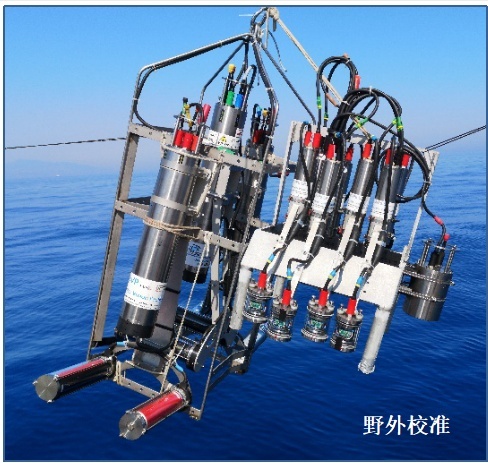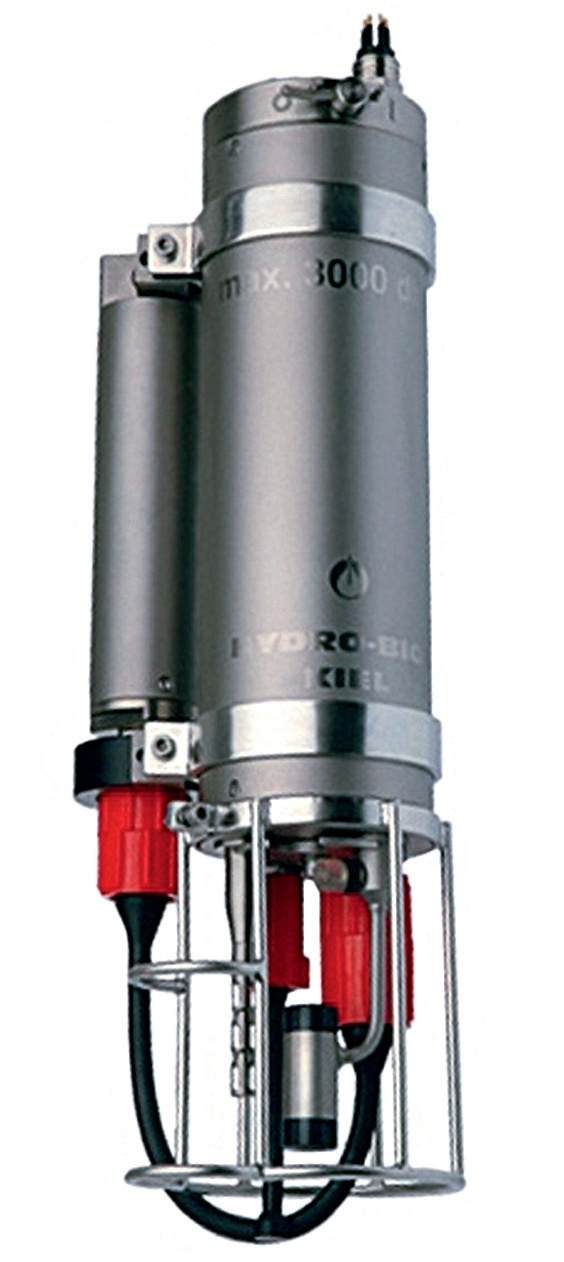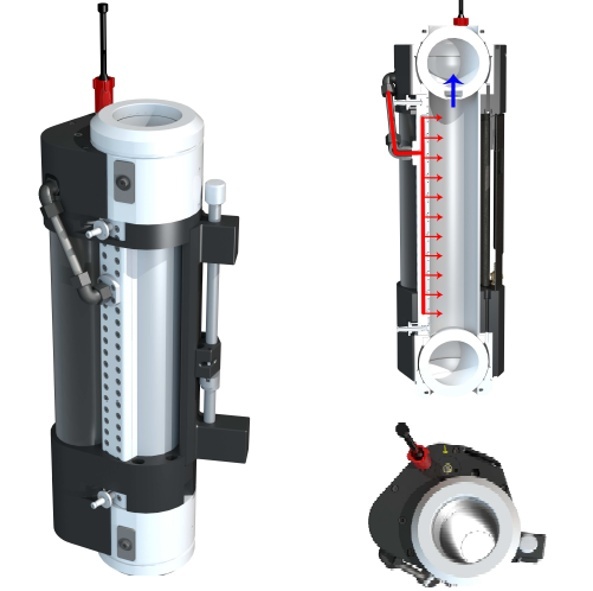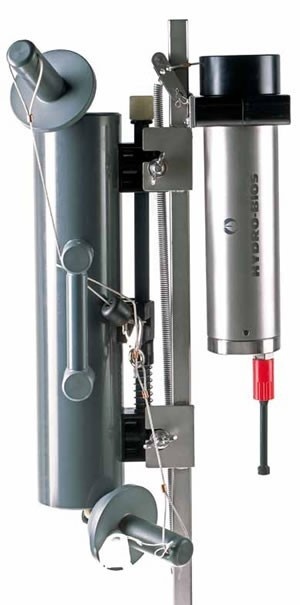參考價(jià)格
面議型號
品牌
產(chǎn)地
德國樣本
暫無看了德國HYDRO-BIOS公司—第三代積分采水器的用戶又看了
 留言詢價(jià)
留言詢價(jià)

虛擬號將在 180 秒后失效
使用微信掃碼撥號
德國HYDRO-BIOS公司—第三代積分采水器
IWS III- Integrating Water Sampler
積分采水器的設(shè)計(jì),是為了與歐盟水框架指令提出的要求相一致,,用于對柱狀水體進(jìn)行積分采樣,。
特點(diǎn):
ü外部電源配備單獨(dú)的外殼
ü快速啟動按鈕-啟動采水器,使用之前編程的采樣深度
ü協(xié)議-集成在OceanLab3軟件中
ü自由設(shè)定深度范圍
新特點(diǎn):
ü手持終端或電腦可以用藍(lán)牙連接
ü無需連接電纜即可對現(xiàn)場采樣預(yù)編程
ü時(shí)間-積分采樣(例如可以對水平采樣過程設(shè)定起始時(shí)間和結(jié)束時(shí)間)
采水器由內(nèi)置的壓力傳感器和電子控制單元來控制,,頂端還配備了小型的馬達(dá)單元,,確保對整個(gè)柱狀水樣在期望的深度進(jìn)行完整的采樣。供電由可充電的LiFePo4蓄電池來提供,。
IWS III使用起來非常簡單:
可以對期望深度(開始深度和結(jié)束深度可自由設(shè)定)進(jìn)行編程,,并將數(shù)據(jù)通過手持終端或電腦的OceanLab 3軟件存儲在采水器中。采水器的推薦下降速度會顯示在手持終端的顯示器上,,然后采水器在水中下降,,電子器件會自動調(diào)節(jié)由于船體的不穩(wěn)定或海面的不平靜,使得采水器的下降速度不穩(wěn)定所帶來的采樣誤差,。到達(dá)結(jié)束深度后,,采水器中的樣品含量為2.5或5L時(shí)被拉起,由于采樣深度可以自由設(shè)定,,可以獲得不同深度的柱狀水樣,。
技術(shù)參數(shù):
長度: 720或880mm
容積: 2.5或5.0L
材質(zhì):POM,丙烯酸塑料,,鈦合金,,不銹鋼
空氣中重量:7.5kg或8kg
操作:一組電池可以執(zhí)行約20次完整采樣工作
**操作深度:100米
選配:
深海版本:**操作深度3000米
在線版本:通過手持終端或者PC進(jìn)行控制和深度讀取(RS232-傳輸距離約50米或FSK單芯電纜,,傳輸距離無限制)
多通道采樣系統(tǒng):安裝到多通道水樣采集器上,,可以同時(shí)進(jìn)行多個(gè)不同深度的采樣
積分采水器訂購信息:
436 601 第三代積分采水器,,2.5 L,100m
436 602 第三代積分采水器,,2.5 L,,3000m
436 606 第三代積分采水器,5.0 L,,100m
436 607 第三代積分采水器,,5.0 L,3000m
代表文獻(xiàn):
1.Edwin T.H.M. Peeters,, Jean J.P. Gardeniers,, Albert A. Koelmans,2000.Contribution of trace metals in structuring in situ macroinvertebrate community composition along a salinity gradient.Environmental Toxicology and Chemistry.19(4):1002-1010.
2.K. G. Schulz,, R. G. J. Bellerby,, C. P. D. Brussaard, J. Büdenbender,, J. Czerny,, A. Engel,, M. Fischer,, S. Koch-Klavsen, S. A. Krug,, S. Lischka,, A. Ludwig, M. Meyerh?fer,, G. Nondal,, A. Silyakova, A. Stuhr,, and U. Riebesell,,2012.Temporal biomass dynamics of an Arctic plankton bloom in response to increasing levels of atmospheric carbon dioxide.Biogeosciences Discussions.9:12543-12592.
3.Czerny, Jan,, Schulz,, Kai G., Boxhammer,, Tim,, Bellerby, R. G. J.,, Büdenbender,, Jan, Engel,, Anja,, Krug,, Sebastian, Ludwig,, Andrea,, Nachtigall, Kerstin,, Nondal,, G., Niehoff,, B.,, Siljakova, A. and Riebesell,, Ulf,,2012.Element budgets in an Arctic mesocosm CO2 perturbation study.Biogeosciences Discussions.9 (8):11885-11924.
4.S. D. Archer, S. A. Kimmance,, J. A. Stephens,, F. E. Hopkins, R. G. J. Bellerby,, K. G. Schulz,, J. Piontek, and A. Engel,,2012.Contrasting responses of DMS and DMSP to ocean acidification in Arctic waters.Biogeosciences Discussions.9:12803-12843.
5.Leu,, E., Daase,, M.,, Schulz, Kai G.,, Stuhr,, Annegret and Riebesell, Ulf,,2012.Effect of ocean acidification on the fatty acid composition of a natural plankton community.Biogeosciences Discussions.9 (7):8173-8197.
6.M. Sperling,, J. Piontek, G. Gerdts,, A. Wichels,, H. Schunck, A.-S. Roy,, J. La Roche,, J. Gilbert, L. Bittner,, S. Romac,, U. Riebesell,, and A. Engel,2012.Effect of elevated CO2 on the dynamics of particle attached and free living bacterioplankton communities in an Arctic fjord.Biogeosciences Discussions.9:10725-10755.
7.Kluijver,, A. de,,2012.Carbon flows in natural plankton communities in the Anthropocene.Geowetenschappen Proefschriften.1-118.
8.K. G. Schulz, U. Riebesell,,2012.Diurnal changes in seawater carbonate chemistry speciation at increasing atmospheric carbon dioxide.Marine Biology.DOI 10.1007/s00227-012-1965-y.
9.J. Hua,, W.H. Hwang,2012.Effects of voyage routing on the survival of microbes in ballast water.Ocean Engineering.42:165-175.
10."T. Tanaka,, S. Alliouane,, R. G. B. Bellerby, J. Czerny,, A. de Kluijver,, U. Riebesell6, K. G. Schulz,,
A. Silyakova,, and J.-P. Gattuso",2013.Effect of increased pCO2 on the planktonic metabolic balance during a mesocosm experiment in an Arctic fjord.Biogeosciences(BG).10:315–325.
11.A. de Kluijver,, K. Soetaert,, J. Czerny, K. G. Schulz,, T. Boxhammer,, U. Riebesell,, and J. J. Middelburg,,2013.A 13C labelling study on carbon fluxes in Arctic plankton communities under elevated CO2 levels.Biogeosciences(BG).10:1425-1440.
12.Czerny, Jan,, Schulz,, Kai G., Ludwig,, Andrea and Riebesell,, Ulf,2013.A simple method for air–sea gas exchange measurements in mesocosms and its application in carbon budgeting.Biogeosciences(BG).10 (3):11989-12017.
13.F. E. Hopkins,, S. A. Kimmance1,, J. A. Stephens, R. G. J. Bellerby,, C. P. D. Brussaard,, J. Czerny, K. G. Schulz,, and S. D. Archer,,2013.Response of halocarbons to ocean acidification in the Arctic.Biogeosciences(BG).10:2331-2345.
14.Czerny,, Jan, Schulz,, Kai G.,, Boxhammer, Tim,, Bellerby,, R. G. J., Büdenbender,, Jan,, Engel, Anja,, Krug,, Sebastian, Ludwig,, Andrea,, Nachtigall, Kerstin,, Nondal,, G., Niehoff,, B.,, Silyakova, A. and Riebesell,, Ulf,,2013.Implications of elevated CO2 on pelagic carbon fluxes in an Arctic mesocosm study – an elemental mass balance approach.Biogeosciences(BG).10 (5):3109-3125.
15.R. Zhang, X. Xia,, S. C. K. Lau,, C. Motegi, M. G. Weinbauer,, and N. Jiao,,2013.Response of bacterioplankton community structure to an artificial gradient of pCO2 in the Arctic Ocean.Biogeosciences(BG).10, 3679–3689,, 2013.
暫無數(shù)據(jù),!
 德國HYDRO-BIOS公司—第三代積分采水器的工作原理介紹,?
德國HYDRO-BIOS公司—第三代積分采水器的工作原理介紹,? 德國HYDRO-BIOS公司—第三代積分采水器的使用方法,?
德國HYDRO-BIOS公司—第三代積分采水器的使用方法,? 德國HYDRO-BIOS公司—第三代積分采水器多少錢一臺?
德國HYDRO-BIOS公司—第三代積分采水器多少錢一臺? 德國HYDRO-BIOS公司—第三代積分采水器使用的注意事項(xiàng)
德國HYDRO-BIOS公司—第三代積分采水器使用的注意事項(xiàng) 德國HYDRO-BIOS公司—第三代積分采水器的說明書有嗎,?
德國HYDRO-BIOS公司—第三代積分采水器的說明書有嗎,? 德國HYDRO-BIOS公司—第三代積分采水器的操作規(guī)程有嗎,?
德國HYDRO-BIOS公司—第三代積分采水器的操作規(guī)程有嗎,? 德國HYDRO-BIOS公司—第三代積分采水器的報(bào)價(jià)含票含運(yùn)費(fèi)嗎?
德國HYDRO-BIOS公司—第三代積分采水器的報(bào)價(jià)含票含運(yùn)費(fèi)嗎? 德國HYDRO-BIOS公司—第三代積分采水器有現(xiàn)貨嗎,?
德國HYDRO-BIOS公司—第三代積分采水器有現(xiàn)貨嗎,? 德國HYDRO-BIOS公司—第三代積分采水器包安裝嗎,?
德國HYDRO-BIOS公司—第三代積分采水器包安裝嗎,? 手機(jī)版:
手機(jī)版:




